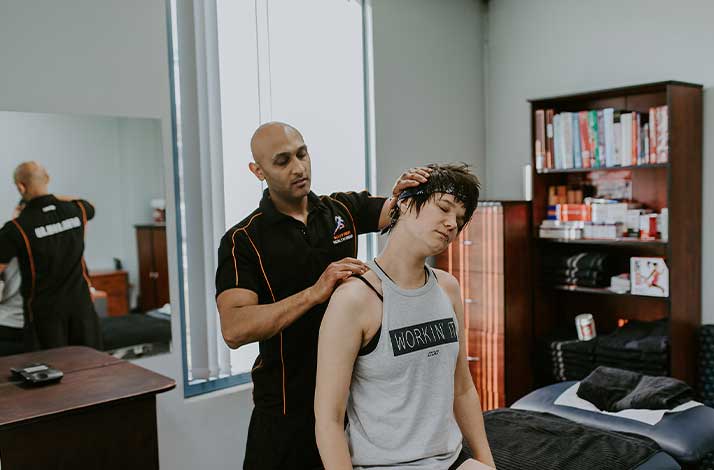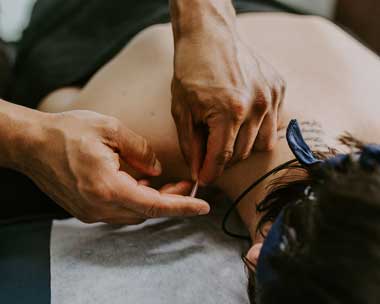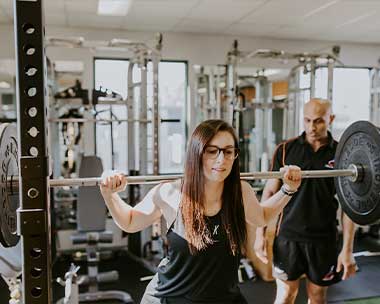Clinical Myotherapy & Remedial Massage

What is Clinical Myotherapy?
Clinical Myotherapy is an evidence based approach to the assessment, treatment and management of muscles, nerves, joints, ligaments and tendons.
It can be used in the treatment of acute or chronic conditions and can assist with pain management with a focus on preventive management. Clinical Myotherapists have completed a Bachelor of Health Science in Clinical Myotherapy, which is a four year government accredited degree, and practice as professional registered practitioners. All degree qualified Clinical Myotherapists have attained the same qualification which means they offer the highest standard of service and will treat similarly to each other. At BFHG, all our Clinical Myotherapists are degree qualified.
How is Myotherapy different to Remedial Massage and Massage?
Clinical Myotherapy is the highest qualification out of these three disciplines. Clinical Myotherapists are highly qualified practitioners who know the body inside – out and have undergone rigorous training to attain their degree. They are specialists in musculoskeletal pain and are considered allied health professionals. They are equivalent to other allied health disciplines such as physiotherapists, osteopaths and chiropractors. If you are considering seeking advice from a practitioner in one of these professions you can also seek advice from a Clinical Myotherapist.
Clinical Myotherapists are often confused as ‘remedial’ or ‘massage’ therapists because they use both soft tissue and deep tissue massage techniques as part of their treatments when required – just like other allied health professionals. Degree qualified Clinical Myotherapists will also use clinical reasoning based on evidence based research and use a range of other treatment techniques, whereas Remedial Massage and Massage Therapists most likely won’t. Unfortunately, this is why there are many misconceptions about Myotherapy amongst consumers. According to consumers, Myotherapy is still misunderstood and undefined. People who have completed diplomas in Remedial Massage incorrectly market themselves as Myotherapists. This confuses the consumers and therefore the service offered by degree qualified practitioners. To make sure your practitioner is highly qualified, you should seek a Clinical Myotherapist who is registered with the Myotherapy Association Australia. At BFHG, we only have degree qualified Clinical Myotherapists.
Can Clinical Myotherapy Be Claimed?
Registered Clinical Myotherapists have provider numbers and services can be claimed on:
- Private health funds
- Work Cover
- TAC
If you would like further information about our Clinical Myotherapy services or would like to make an appointment please contact us by email info@bfhg.com.au
Remedial Massage
At BFHG, we see remedial massage as an extremely valuable form of therapy. Remedial massage can provide pain and tension relief. It is used to manipulate tissue that is damaged, knotted or tense. A quality remedial massage session with an accredited therapist is an excellent way to sooth sore, tired, fatigued muscles. At BFHG, remedial massage can be provided by our Clinical Myotherapists.
Clinical Myotherapy Treatment Techniques
All treatment techniques are used to decrease muscle tension and nerve pain, heal damaged tissue and lead to an increase in range of movement. Treatments can often be used in combination for greater effect.
After a thorough assessment, a Clinical Myotherapist may use some of the following techniques in your treatment:
Dry Needling
The use of needles (which are the same as acupuncture needles) to target and treat trigger points which are knots in muscles and to reduce pain by blocking pain pathways. Clinical Myotherapists have the most training and are the highest qualified practitioners in dry needling and therefore are considered the industry specialists.
Soft and Deep Tissue Techniques
Soft tissue and deep tissue manipulation refers to the use of soft and/or deep pressure to relieve tension in muscles. When used correctly and with an ‘evidence based approach’, results are completely different to a soft, relaxing massage.
Joint Mobilisation
Joint mobilisation refers to the mobilisation of joints with controlled pressure which forces more movement to a restricted or stiff joint. It is a safe method as it works within the joints natural range of movement. Clinical Myotherapists are qualified to do mobilisation on any joint in the skeletal system.
Electrotherapy
Electrotherapy is the use of electrical stimulation. There are a number forms of electrotherapy including:
- TENS – Transcutaneous Electrical Nerve Stimulation
- TEMS – Transcutaneous Electrical Muscle Stimulation
Both TENS and TEMS rely on the correct application of pads to target muscle and nerves respectively to relieve pain and muscle tension. Clinical Myotherapists know the correct placement and settings in terms of ‘intensity’ and ‘pulse’ to achieve different effects. The main therapeutic effects of TENS and TEMS based on different settings include:
- Pain relief – by blocking the pain pathways. This can be used for acute pain or chronic pain.
- Nerve stimulation – often used to re-train and stimulate under functioning or damaged nerves. Nerves are the communication system in the human body. If they are not working effectively this can lead to many long term deficiencies and conditions.
- Vasodilation – is an increase in blood flow which provides natural healing properties to any tissue.
- Muscle metabolism and stimulation – with correct stimulation muscle metabolism can increase tissue health and growth. Similar to under functioning nerves, under functioning muscle can lead to long term conditions and deficiencies.
Electro-needling
This is the combination of dry needling and electrotherapy. Clinical Myotherapists are specialists in this type of treatment and guarantee correct use and application to get the best outcome.
Myofascial Cupping
The use of suction cups to apply a vacuum over and around the site of pain. The vacuum effect lifts and separates the layers of tissue (i.e skin, muscle and other layers) and creates a significant amount of blood flow to the area which assists with healing. It pulls the tissue which creates a stretch. It also decompresses the affected area, releasing any toxins and fluid restrictions. This decompression also takes pressure off nerves and therefore relieves the nerve irritation that causes pain.
Stretching
Stretching is the lengthening of tissues. This can be done actively (by you) or passively (by your physical therapist). Different types of stretching which may be performed by Clinical Myotherapist include:
- Myofascial
The stretching of your myo (muscle) and fascia:
Myo (muscle) – when muscles are tight they shorten. Stretching a muscle lengthens it, improving mobility, blood flow and therefore decreasing pain.
Fascia – refers to skin and connective tissue above, below and around muscle, nerve and vascular tissue. Any restriction to any of these structures can cause pain. Stretching can relieve restriction and pressure and thus decrease pain.
- Neural
The stretching ofnerves. Like muscles and fascia, nerves can be injured, entrapped and damaged. Nerves are usually entrapped and/or damaged in common areas of the body. When they are damaged they are likely to refer pain wherever the nerve branches follow i.e down the limbs. Neural stretching can relieve restrictions, entrapments and therefore nerve pain.
- Joint
The stretching of joints. Joints can be restricted by anything that is attached to it or potentially a damaged structure inside it. When joints are inflamed, space inside is then compromised and restricted. Careful joint stretching can assist with healing, mobility and decrease pain.
Thermal therapies
The use of hot and cold to regulate the temperature of the body.
- Heat is used to promote blood flow which will assist with healing via delivery of nutrients to an injured area. Heat will also expand tissues and release pressure from nerves and other compressed structures.
- Ice is used to reduce blood flow to an injured area. Whenever there is an injury, there is an immediate reaction of fluid from the body called ‘inflammation’. This is a ‘soup’ of healing chemicals, pain receptors and white blood cells. The effect of this response can, however, remain in and around the damaged area longer than necessary. This is what we refer to as inflammation. Ice removes blood flow from the area and therefore reduces the excess fluid and associated pain. Ice also reduces pain around nerves as it partially ‘numbs’ the nerve and inflammation surrounding it.
Taping
The use of tape creating external forces such as support, hold, increase blood flow etc. Clinical Myotherapists use the following taping methods:
- Sports – the use of tape generally to support joints, reduce pain and increase comfort when playing a sport. Clinical Myotherapists have an in-depth understanding of anatomy. Depending on your pain and movement, taping is always customised to reduce your specific pain.
- Kinesiology – a form of elastic taping which is used to stimulate the soft tissue of the body as opposed to restricting it like the sports tape. By applying a light stretch on the tape and applying it the correct way, the kinesiology tape can improve blood flow to tendons, muscles and fascia, improve nerve flow and stretch muscles and joints.
- Postural – bad posture puts stress on the joints, tendons, muscle and nerves. Taping can be used to support, hold and re-train movements and posture to assist with decreasing pain and improving function.
- Recovery –taping may also be considered as a form of recovery. Following damage to a joint, it may be unstable and ‘loose’. Taping may be used to support a joint allowing the soft tissue (tendons, ligaments, muscles and nerves) and internal structures of the joint to repair and recover without repetitive stress.
Prescriptive Exercises
The prescription of exercises that will improve your condition and reduce the chance of injury. Exercises are specific to each individual and their injury. A common situation is that a new client presents with a reoccurring injury. The majority of the time the client has been given the incorrect exercises or even worse no exercises at all!
Pain Management and Prevention
This is a continuation from the prescriptive exercises and refers to the ongoing management of pain which will lead to injury prevention. This can be undertaken by the client independently or with the assistance of a Clinical Myotherapist.
What injuries and conditions can Clinical Myotherapists treat?
Clinical Myotherapists are qualified to treat, manage and rehabilitate any injury related to muscle, nerves or joints. Common injuries that can be treated include:








